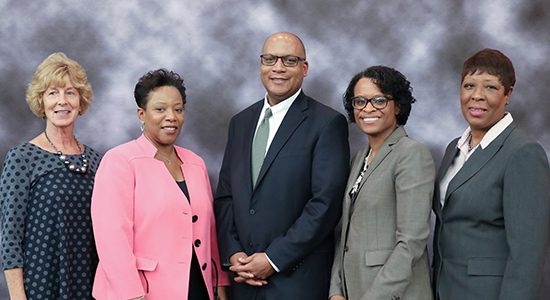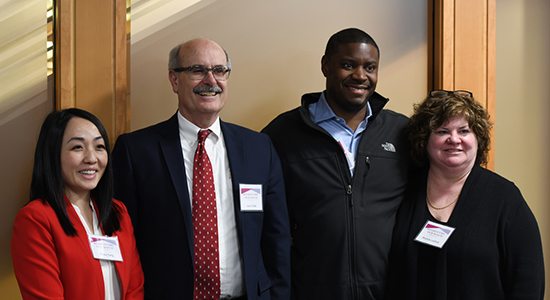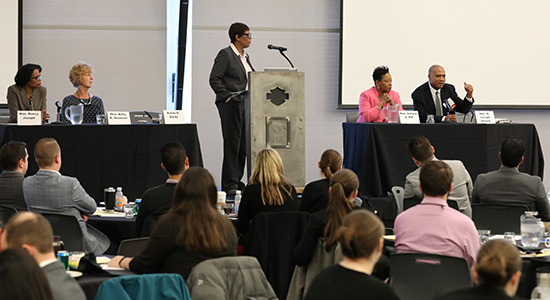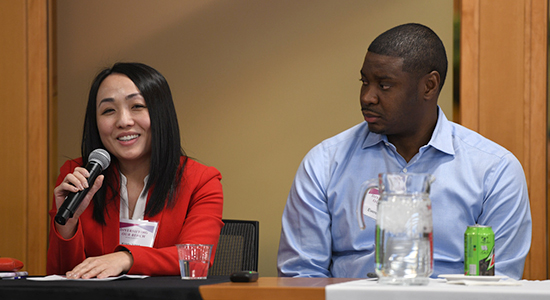
The panelists on the YLD Conference's Diversity from the Bench panel in Milwaukee, from left: Wisconsin Court of Appeals District I Judge Kitty Brennan, Milwaukee Municipal Court Judge Valarie Hill, Milwaukee County Circuit Court Judge Joseph Donald, Magistrate Judge Nancy Joseph of the U.S. District Court for the Eastern District of Wisconsin, and attorney Karen Dardy of Milwaukee.
April 18, 2018 – Before Milwaukee County Circuit Court Judge Joe Donald was a judge, he was a law clerk for that court in the late 1980s. Occasionally, working late, he would do something any young, aspiring judge might do: pretend to be the sitting judge.
“I would sneak onto the bench, sit in that big comfy chair and think, ‘wow, this is really nice,” Judge Donald joked in March at the 2018 Young Lawyers Conference in Milwaukee, sponsored by the State Bar of Wisconsin’s Young Lawyers Division (YLD).
In 1996, after Donald served seven years as an assistant city attorney in Milwaukee – and after tapping every connection he could think of to draw then-Gov. Tommy Thompson’s ear – he was appointed to the circuit court bench. He has remained there 22 years, with voter approval and re-approval, rising to deputy chief judge.
But Judge Donald, who is African-American, is among a distinct minority. According to a recent study, only 4 percent of Wisconsin judges are men of color, whereas men of color represent 9 percent of the state’s population, marking a 5 percent disparity.
This is just one statistic from a larger data set that ranks Wisconsin 44th out of 50 states ranked for diversity on the bench. Wisconsin received an “F” for diversity – the demographic of Wisconsin judges is far from representative of the population.
In recent months, judges on various panels in Milwaukee and Madison, sponsored by different groups, have addressed the importance of a diversified bench and their own paths to bench. They have also imparted wisdom for those attorneys who are thinking of a possible judicial career.

The panelists on the Diversity from the Bench CLE Series in Madison, presented by the Association for African-American Lawyers (WAAL) and other specialty bars, from left: Milwaukee Circuit Court Judge Kristy Yang, and Dane County Circuit Court judges Juan Colas, Everett Mitchell, and Rhonda Lanford. Photo copyright Tatiana Shirasaki.
Lagging Behind
No other state high court in the country will have more women, by percentage, than the Wisconsin Supreme Court when Judge Rebecca Dallet begins her 10-year term in August. Six of the supreme court’s seven justices will be women (85 percent).
 Joe Forward, Saint Louis Univ. School of Law 2010, is a legal writer for the State Bar of Wisconsin, Madison. He can be reached by email or by phone at (608) 250-6161.
Joe Forward, Saint Louis Univ. School of Law 2010, is a legal writer for the State Bar of Wisconsin, Madison. He can be reached by email or by phone at (608) 250-6161.
But that’s not representative of the state’s bench as a whole. While women represent 50 percent of Wisconsin’s population, only 20 percent of Wisconsin judges are women, according to data by the American Constitution Society for Law and Policy.1
Contrast those statistics with Minnesota, ranked No. 5 for diversity on the bench, where women make up 50 percent of the population and occupy 39 percent of the bench.
Wisconsin lags far behind on gender diversity. And it’s not due to a shortage of women in the profession. For decades, the ratio of men to women graduating from law school has hovered close to 50/50. Currently, the State Bar membership is 38 percent women.
Wisconsin Appeals Court Judge Kitty Brennan says the judiciary is stuck on gender disparity, but it’s not just the judiciary. Women leave the legal profession in general.
“I think a lot of it has to do with family,” she said at the YLD event. “It’s very hard to practice and have children. That is a loss for the profession and the community.”
What about women of color? Only 1 percent of Wisconsin judges are women of color, but they represent 9 percent of the population. Contrast that with Minnesota, where women represent 9 percent of the population and occupy 7 percent of the bench.
When the bench looks more like the community, it instills trust in the voters and the people who use the court system.
Wisconsin’s bench is lagging by race, ethnicity, and gender. While 76 percent of judges are white men, white men make up 41 percent of the state’s population.
“The bench ought to be representative of the society at large,” said Dane County Circuit Court Judge Juan Colas, who participated in a panel on diversifying the bench in Madison earlier this month.
The Madison panel, hosted by Foley & Lardner LLP, was part of a CLE series developed by the Association for African-American Lawyers (WAAL), in collaboration with the Wisconsin Hispanic Lawyers Association, the Wisconsin Asian-American Bar Association, the LGBT Bar Association of Wisconsin, the American Constitution Society, and Law Alliance.
“Diversity also matters in the variety of viewpoints and perspectives that are brought to bear on judicial questions,” said Judge Colas, born in Columbia. “It makes a difference when you are exchanging views with other judges who bring different viewpoints.”
The perception of justice is also important, said Milwaukee Circuit Court Judge Kristy Yang, elected last year to become the first Hmong-American judge in Wisconsin and the second Hmong-American judge in the country. “When the bench looks more like the community, it instills trust in the voters and the people who use the court system.”

The YLD Conference's Diversity from the Bench panel in Milwaukee, from left: Magistrate Judge Nancy Joseph of the U.S. District Court for the Eastern District of Wisconsin, Wisconsin Court of Appeals District I Judge Kitty Brennan, emcee Karen Dardy of Milwaukee, Milwaukee Municipal Court Judge Valarie Hill, and Milwaukee County Circuit Court Judge Joseph Donald.
Broad Diversity Matters
While the law guides judicial decisons, the panelists all agreed that racial, ethnic, gender, and cultural diversity on the bench are important measures of a fair and just system. But the measure of diversity is even broader.
Diversity, many noted, is also inclusive of sexual orientation, socioeconomic status, practice experience, professional and personal background, and other life experiences.
Dane County Circuit Court Judge Rhonda Lanford's personal background gives her perspective and insight on the struggles of low-income people. "I came from a very humble beginning, a below the poverty line family," said Lanford at the CLE series in Madison. Lanford was a personal injury litigator at Habush Habush & Rottier, S.C., before running for judge in 2013.
“We had all the issues that come with poverty: Not having enough food, not being able to pay the bills. My house was foreclosed on when I was growing up. That’s my family experience. So I have a certain level of empathy when people come in front of me. I know things can happen to people.”
"From the diversity perspective, I'm also a lesbian," Lanford said. "There's a certain amount of visibility for the gay-lesbian population in having me on the bench."
Bilingual, Judge Colas, currently in the juvenile division, can offer words of encouragement in Spanish, to Spanish-speaking parents. The connection makes a difference, he said.
“We live in a democracy, and there is a sense of representation on the bench, particularly since we have an elected judiciary,” Judge Colas noted.
When African-American litigants enter Judge Donald’s courtroom and see his African-American staff, they feel that they are going to be treated fairly. Even if the decision does not go their way, Judge Donald said, “they will feel like they have been heard.”
Life experiences, including a traumatizing childhood, help Dane County Judge Everett Mitchell, who is African-American, connect with traumatized children. And his perspectives brought policy changes on juvenile shackling in the courtroom.
“When you come from a traumatized place, jail may be better than your real life,” Judge Mitchell said at the Madison event. “I’m able to bring that perspective to these young people. Understanding that helps kids feel more comfortable. They feel like I have listened to them.”
Judge Mitchell didn’t learn to read until junior college in Texas. He went on to earn degrees from Morehouse College, Princeton University, and U.W. Law School. “When they say these kids are beyond repair, I say no, they just need to be safe.”

Milwaukee Circuit Court Judge Kristy Yang and Dane County Circuit Court Judge Everett Mitchell at the Madison panel. Photo copyright Tatiana Shirasaki.
What are the Obstacles?
If the goal is to improve diversity on the bench, which can enhance the diversity of judicial viewpoints and increase the public’s confidence in the court system, then what are the barriers that prevent Wisconsin from moving toward improved diversity?
Although justices must be elected in Wisconsin, many are appointed to fill vacant seats first. So many judges are propelled with an appointment from the governor.
“If the governor is a Republican, there’s a good chance those being appointed are those of the Republican persuasion,” said Milwaukee Municipal Court Judge Valerie Hill said at the YLD event in Milwaukee.
“Same thing for Democrats. Every now and then, it doesn’t work that way and for judges, and it shouldn’t matter, but we all know it does. So broaden your circle.”
I am a firm believer that the pipeline has to start before law school, in high school and even younger.
Thus, politics matters. But so does the pipeline. How can Wisconsin achieve diversity if there isn’t a diverse pool of candidates for judicial positions?
“I am a firm believer that the pipeline has to start before law school, in high school and even younger,” said Magistrate Judge Nancy Joseph of the U.S. District Court for the Eastern District of Wisconsin. “We need to plant the seeds when they are young.”
The pipeline, Judge Colas said, is necessary to improve diversity in law schools and get people on the right path so that judgeship is a viable option. “We need a big enough pool of people who have the necessary education and accumulation of experiences.”
And Judge Mitchell says Wisconsin’s communities must figure out how to keep diverse candidates from leaving the state after graduating from U.W. or Marquette law schools.
Taking the Plunge
Judge Brennan, who was appointed to the Wisconsin Court of Appeals in 2008 but previously served as a circuit court judge in Milwaukee County for 13 years – she was the court’s first female chief judge – says the bench “isn’t for everyone.”
And Magistrate Judge Joseph says those interested must spend the time to research what judges do, at different levels of the court system, and talk to judges.
“You may be an excellent lawyer and it may suit you very well, but you may decide after doing your research that judging is not what you want to do,” Judge Joseph said.
We can encourage people to be brave and run.
Other panelists talked about the will to campaign, a full-time job in itself that costs money, and may cause both personal and professional stress. Those who are appointed must sit for election eventually. They need a strategy and a plan.
“Money is not everything but it helps,” said Judge Yang, who campaigned for nine months. “There’s a lot of ups and downs. Some people will hate you for no reason, others will love you for no reason. It’s all about meeting people where they are.”
But what more can be done, besides preparing a larger pipeline of lawyers for a path to the bench? “We can encourage people to be brave and run,” Judge Lanford said.
“Many times, especially among women who are considering running, they are fearful of not being taken seriously,” Lanford continued. “I felt that way, and I’m a pretty strong personality. We can encourage people to take the opportunities and be fearless.”
Correction: The original version of this article reported that the CLE series on Diversifying the Bench, developed by WAAL and other bar associations, was an offshoot of the YLD Conference event. That was incorrect. WAAL's CLE series and the YLD event were seperate events sponsored by different groups.
Endnote
1 The Gavel Gap. Go to Wisconsin-specific data.
